136th Airlift Wing
| 136th Airlift Wing | |
|---|---|
|
136th Airlift Wing C-130H over Fort Worth, Texas | |
| Active | 1943–present |
| Country |
|
| Allegiance |
|
| Branch |
|
| Type | Wing |
| Role | Airlift |
| Part of | Texas Air National Guard |
| Garrison/HQ | Naval Air Station Joint Reserve Base Fort Worth, Fort Worth, Texas |
| Nickname(s) | Silver Eagles |
| Motto(s) | Nulli Secundus (Second to None) |
| Tail Code |
|
| Engagements | World War II |
| Insignia | |
| 136th Airlift Wing emblem |
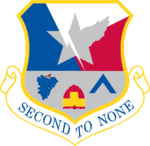 |
The 136th Airlift Wing (136 AW) is a unit of the Texas Air National Guard, stationed at Naval Air Station Joint Reserve Base Fort Worth, Fort Worth, Texas. If activated to federal service, the wing is gained by the United States Air Force Air Mobility Command.
Overview
The 136th Airlift Wing's C-130 Hercules mission is to perform the tactical portion of the airlift mission. The aircraft is capable of operating from rough, dirt strips and is the prime transport for air dropping troops and equipment into hostile areas. The C-130 performs a diverse number of roles, including airlift support, Antarctic ice resupply, aeromedical missions, weather reconnaissance, aerial spray missions, firefighting duties for the U.S. Forest Service, and natural disaster relief missions. The wing is collocated with the navy, marines, air force reserve, coast guard and army at the Naval Air Station, Joint Reserve Base (NAS JRB), on Carswell Field.
Units
The 136th Airlift Wing is composed of 5 groups, 19 units and 1 geographically separated unit (GSU).
- 136th Operations Group
- 181st Airlift Squadron
- 136th Operations Support Squadron
- 181st Airlift Control Flight
- 181st Weather Flight
- 136th Mission Support Group
- 136th Maintenance Group
- 136th Medical Group
- 254th Combat Communications Group
History
World War II

Established in mid-1943 as a P-47 Thunderbolt fighter group, trained under I Fighter Command on Long Island and Massachusetts. Moved to England, arriving in January 1944. Began operations with IX Fighter Command on 14 March when the group flew a fighter sweep over the English Channel coast of France. Made strafing and bombing attacks on airfields, rail and highway bridges, trains, vehicles, flak positions, and V-weapon sites to help prepare for the invasion of France.
Supported the landings in Normandy early in June 1944 and began operations from the Continent later the same month. Aided in the taking of Cherbourg, participated in the air operations that prepared the way for the Allied breakthrough at St Lo on 25 July, and supported ground forces during their drive across France.
Received a Distinguished Unit Citation for support operations in the vicinity of Mons, Belgium on 3 September 1944 when the group, dispatching seven missions against the enemy on that day, not only destroyed large numbers of motor transports, horse-drawn vehicles, and troops, but also attacked enemy positions that obstructed the progress of ground forces. Continued to support ground forces, participated in the assault against the Siegfried Line, and took part in the Battle of the Bulge (December 1944 – January 1945) by attacking rail lines and trains, marshalling yards, roads and vehicles, armored columns, and gun positions. Operated with the Allied forces that pushed across the Rhine and into Germany.
After V-E Day, served with the Army of Occupation, being assigned to United States Air Forces in Europe. Inactivated in Germany on 20 August 1946
Texas Air National Guard
The wartime 368th Fighter Group was re-designated as the 136th Fighter Group, and was allotted to the Texas Air National Guard, on 21 August 1946. It was organized at Love Field Airport, Dallas, Texas and was extended federal recognition on 27 January 1947 by the National Guard Bureau. The 136th Fighter Group was bestowed the lineage, history, honors, and colors of the 368th Fighter Group. The group was assigned to the Texas Air National Guard 63d Fighter Wing.
The 136th Fighter Group initially consisted of the following:
- 111th Fighter Squadron, stationed at Ellington Field, Houston.
- 181st Fighter Squadron, stationed at Love Field, Dallas.
- 182d Fighter Squadron, stationed at Brooks Field, San Antonio.
In addition, the 136th Material Squadron (Maintenance); 136th Combat Support Squadron and 136th Medical Squadron were activated and assigned to the group at Hensley Field as support elements. F-51D Mustangs were assigned to the Fighter Squadrons, and the mission of the unit was the air defense of Texas. In mid-1950 the Texas Air national Guard received its first jet aircraft, when a few F-84B Thunderjets were assigned to the 181st Fighter Squadron in June.
Korean War Activation
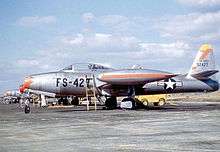
As a result of the Korean War, the Texas Air National Guard was federalized and placed on active-duty status on 10 October 1950, being assigned to Ninth Air Force, Tactical Air Command (TAC). TAC ordered the 136th Fighter Group to Langley Air Force Base, Virginia, where the unit was re-designated to a Fighter-Bomber unit, and its status was changed to a Wing. At Langley, the 136th Fighter-Bomber Wing consisted of the following units:
- 111th Fighter-Bomber Squadron
- 182d Fighter-Bomber Squadron
- 154th Fighter-Bomber Squadron (Arkansas ANG).
The Love Field-based 181st was also re-designated as a Fighter-Bomber Squadron, however it remained in Dallas, the squadron taking over the ANG air defense mission for the entire state of Texas. Subsequently, it was re-equipped with the Very Long Range (VLR) F-51H Mustang, which had been developed to escort B-29 Superfortress bombers in the Pacific Theater from the Mariana Islands to the Japanese Home Islands. Its F-84Bs were reassigned as they lacked the range of the Mustangs.
At Langley AFB, the 136th trained with their F-51D Mustangs. Unfortunately losing two 111th FBS pilots in a training accident on 15 December. A third pilot was killed on 27 January 1951 in another accident. In February 1951, the aged F-51Ds that the unit had been flying since its activation in 1947 were replaced by F-84E Thunderjets, and the squadron began transition training on the jet fighter-bomber. Most of the training took place at Langley, although some pilots were sent to Shaw AFB, South Carolina. Maintenance crews, all new to jet aircraft, were trained at Langley and engine specialists were sent to the Allison plant in Indianapolis. Assigned to the Arkansas ANG 154th FBS at the time was a Navy exchange pilot, future NASA astronaut Lt. Walter Schirra (who happened to be the only pilot assigned to the 136th at the time who was a qualified jet pilot).
In May 1951, less than seven months later, the Wing was deployed to Japan, being attached to Far East Air Force and stationed at Itazuke Air Force Base, the first echelon of the 136th arriving on 18 May. The 136th replaced the Strategic Air Command 27th Fighter-Escort Wing, which had deployed to Far East Air Force in the early days of the Korean War. At Itazuke, the squadrons took over the F-84Es of the 27th FEW, which remained in place, its aircraft being reassigned from SAC to Far East Air Force inventory records. On 2 June, the final elements of the 136th arrived in Japan, the National Guardsmen officially relieved the 27th FBW and the SAC airmen departed for the United States. The 136th was the first Air National Guard Wing in history to enter combat.
From Japan the Wing engaged in combat operations over South Korea, however flying in the North Pacific area was a challenge to the wing, losing seven F-84Es in non-combat operations and three in combat. On 26 June, in one of the largest air-to-air battles in Korea, two 182d FBS pilots, Captain Harry Underwood and 1st LT Arthur Olighter shot down an enemy MiG-15 that broke though an F-86 Sabre escort of four B-29s. Two other 111th FBS pilots, 1st Lt John Morse and John Marlins scored probables in the same encounter. These were the first combat victories by Air National Guard pilots. On 3 July the 136th sent their aircraft to North Korea, attacking FLAK batteries in downtown Pyongyang while other aircraft attacked North Korean airfields.
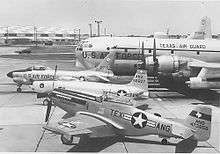
However, the short-legged F-84 had limited combat time over Korea, therefore on 16 November 1951 the Wing moved to Taegu Air Force Base (K-2) in South Korea for its combat operations. In 1952, the 136th was re-equipped with the F-84G Thunderjet, designed for tactical close air support of ground forces.
During its time in combat, the 136th flew 15,515 Combat Sorties; was credited with 4 enemy aircraft destroyed; 7 probables and 72 others damaged. It was the first ANG unit to down a MiG-15; it dropped 23,749 (7,120 tons) of bombs and expended over 3 million rounds of .50 caliber ammunition; being awarded Five Korean Campaign Ribbons. The 136th Fighter-Bomber Wing was released from active duty and returned to the United States on 10 July 1952
Air Defense Command
With the Wing's return from the Korean War, the 111th and the 182d Fighter-Bomber Squadrons joined the 181st FBS with VLR F-51H Mustangs. The 136th Fighter-Bomber Wing was assigned to the Central Air Defense Force, Air Defense Command (ADC) and resumed its postwar mission of Texas air defense.
It was not until 1955 that the Texas Air National Guard received jets from ADC, receiving F-80B and F-80C Shooting Stars and the squadrons being re-designated as Fighter-Interceptor Squadrons. The 111th received F-80C-11 (modified F-80A to F-80C standards) Shooting Stars on 1 July 1955, and on 1 July 1956 the 111th FIS commenced to participate in the active ADC runway alert program at Ellington AFB. The 182d at Brooks AFB received F-80C Shooting Stars in August 1956, replacing some of the last F-51H Mustangs in the USAF inventory. The 181st at Love Field received F-80Cs in January 1955.
On 1 July 1957 the 136th Fighter-Bomber Wing was re-designated an Air Defense Wing and reorganized along Air Defense Command lines. Combat units of the-Wing were selected by the Air Defense Command to man a runway alert program on full 24-hour basis - with armed jet fighters ready to "scramble" at a moment's notice. This event brought the wing into the daily combat operational program of the USAF, placing us on "the end of the runway" alongside regular USAF-Air Defense Fighter Squadrons. The obsolescent F-80 day fighters were upgraded to the all-weather/day/night F-86D Sabre Interceptor for all three squadrons by the end of the year.
Also in 1957, the Texas ANG was authorized to expand the 111th Fighter-Interceptor Squadron at Ellington to a group level, and the 147th Fighter-Interceptor Group was activated in Houston on 1 July. As a result, the 111th FIS was reassigned to the new 147th FIG. On 5 August 1957 the 147th was selected to organize and operate a Jet Instrument School to train Air National Guard pilots throughout the nation. On 1 March 1958 the wing was expanded to include the Louisiana ANG 159th Fighter Group (Air Defense) at New Orleans which placed the Texas Wing in command of all Tactical Air National Guard units in the States of Texas and Louisiana. In July 1960, ADC began upgrading the 111th, 122d and 182d FIS to the Mach-2 F-102A Delta Dagger interceptor.
Air Refueling
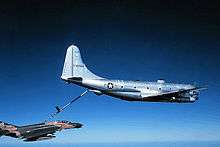
In August 1961, as part of an Air Defense Command re-organization, the Wing's assignment to the ADC Oklahoma City Air Defense Sector was terminated with the inactivation of the OCADS, and the 136th was transferred to Tactical Air Command. As part of the reorganization:
- The 136th Air Defense Group was inactivated.
- The Brooks AFB 182d Fighter-Interceptor Squadron was expanded to a group level forming the 149th Fighter-Interceptor Group under the ADC 31st Air Division.
- The Ellington AFB 147th Fighter-Interceptor Group and New Orleans 159th Fighter-Interceptor Group also remained with ADC, being reassigned to the 31st Air Division.
The 136th Air Defense Wing and its 181st Fighter-Interceptor Squadron were realigned to an air refueling mission, becoming the 136th Air Refueling Wing and 181st Air Refueling Squadron under the TAC Ninth Air Force. The 181st ARS was equipped with KC-97L Stratotankers, its mission becoming the air refueling of primarily Tactical Air Command fighter aircraft. Also, the 181st was moved from Dallas Love Field to Naval Air Station Dallas (Hensley Field), which ended a debate about the Texas Air National Guard operating from the expanding civilian airport.
With the transfer of the interceptors and no previously qualified aircrew or maintenance personnel assigned the 136th went though a year of transition to the new mission and to achieve operational status. They did so in eight months, the previous "normal" time for the conversion was two years. In 1966 the squadron began a rotational deployment to Ramstein Air Base in support of Operation Creek Party. which provided USAFE an air refueling capability. The Creek Party deployment rotations lasted until 1976, and over the decade the 136th saw millions of pounds of jet fuel off-loaded and millions of miles flown, all accident free. In July 1976 the KC-97s were retired and the 136th was transferred to Strategic Air Command, receiving jet KC-135A Stratotankers. Under SAC, the 181st Air Refueling Squadron mission included the air refueling of B-52 Stratofortress intercontinental bombers along with TAC and Aerospace Defense Command interceptors.
Tactical Airlift
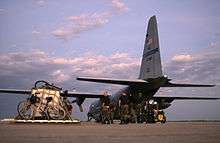
On 1 April 1978, the 136th was reassigned from SAC to Military Airlift Command (MAC), and was realigned to a Tactical Airlift Wing, being re-equipped with C-130B Hercules transports. The new 136 TAW mission was airlift of troops, military equipment, cargo and aeromedical support.
The 136th TAW and its subordinate units participated in numerous Cold War military exercises such as Team Spirit, Volant Oak, Red Flag, and Reforger. Other Joint Chief of Staff exercises included "Ember Dawn IV" in Alaska and "Brave Shield" in Europe. In 1979, the Air National Guard and Air Force Reserve assumed full responsibility for airlift operations in Panama.
In mid-December 1989, and continuing for several weeks, wing aircraft, air crews, and support personnel on deployment for exercise Volant Oak at Howard AFB, Canal Zone, Panama, flew combat airlift missions for U. S. Southern Command during Operation Just Cause in Panama. More than 100 combat sorties were flown by 146th aircraft and crews, with no casualties or damage to aircraft.

In August 1986 the Wing received the new C-130H aircraft. In August 1990, the world was moving swiftly toward armed confrontation in the Persian Gulf. By late January 1991, the 136th Airlift Wing had provided U. S. Central Command and U. S. Air Forces in Europe personnel, voluntarily and involuntarily activated, who participated in Operation Desert Shield and Operation Desert Storm. Aircraft and air crews from the 181st Airlift Squadron flew two month-long tours of duty in Operation Volant Pine, a backfill of military airlifters to Europe by Air National Guard C-130s.
In 1997, wing members deployed supporting State and Federal missions. During the period the unit played critical roles in support of DoD missions deploying to Oman and Saudi Arabia in support of Southern Watch, and in peacetime humanitarian airlift, among the many missions accomplished by the wing during the award period.
On 1 October 1998 with the closure of Hensley Field, the 136th Airlift Wing moved to the former Carswell Air Force Base, now designated as Naval Air Station Joint Reserve Base Fort Worth.
As part of the Global War on Terrorism, the 136 AW has deployed numerous times totaling more than 6,000 Airmen since 9/11/2001 in support of Operation Noble Eagle, Operation Iraqi Freedom, Operation Enduring Freedom, Operation New Horizons, an average of six deployments per unit member.
Lineage


- Constituted as 368th Fighter Group on 24 May 1943
- Activated on 1 June 1943
- Inactivated in Germany on 20 August 1946
- Re-designated 136th Fighter Group and allocated to Texas ANG on 21 August 1946
- Extended federal recognition on 27 January 1947
- Established as: 136th Fighter Wing, and allotted to Texas ANG, 31 October 1950
- Organized and received federal recognition, 1 November 1950, assuming personnel and equipment of 63d Fighter Wing (Inactivated)
- 136th Fighter Group assigned as subordinate unit
- Ordered into active service on 10 October 1950
- Re-designated 136th Fighter-Bomber Wing, 19 April 1951
- Group re-designated 136th Fighter-Bomber Group
- Released from active duty and returned to Texas state control, 10 July 1952
- Re-designated: 136th Fighter-Interceptor Wing, on 10 July 1952
- Group re-designated 136th Fighter-Interceptor Group
- Re-designated: 136th Fighter-Bomber Wing, 1 January 1953
- Group re-designated 136th Fighter-Bomber Group
- Re-designated: 136th Air Defense Wing, 1 July 1955
- Group re-designated 136th Fighter Group (Air Defense)
- Re-designated: 136th Air Refueling Wing, 1 September 1961
- Group re-designated 136th Air Refueling Group
- 136th Air Refueling Group inactivated 30 June 1974
- Re-designated: 136th Tactical Airlift Wing, 1 July 1978
- Re-designated: 136th Airlift Wing, 16 March 1992
- Group re-activated and re-designated as 136th Operations Group
Assignments
- I Fighter Command, 1 June 1943
- Attached to: New York Fighter Wing, 23 August – 20 December 1943
- IX Fighter Command, 13 January 1944
- 71st Fighter Wing
- Attached to: IX Tactical Air Command, 1 August 1944
- Attached to: IX Tactical Air Command, 1 October 1944
- XIX Tactical Air Command, 16 January 1945
- United States Air Forces in Europe
- Attached to: XII Tactical Air Command, 16 November 1945 – 20 August 1946
- 71st Fighter Wing, 27 January 1947
- 63d Fighter Wing, 23 May 1948
- Ninth Air Force, Tactical Air Command, 10 October 1950
- Attached to: Far East Air Forces, 14 May 1951
- Further attached to: Fifth Air Force, 19 September 1951-10 Jul 1952
- Texas Air National Guard, 10 Jul 1952–Present
- Gained by: Central Air Defense Force, Air Defense Command
- Gained by: Oklahoma City Air Defense Sector, Air Defense Command, 1 January 1960
- Gained by: Tactical Air Command, 1 September 1961
- Gained by: Eighth Air Force, Strategic Air Command, 1 July 1976
- Gained by: Air Mobility Command, 1 June 1992
- Gained by: Air Combat Command, 1 October 1993
- Gained by: Air Mobility Command, 1 April 1997-Present
Components
World War II
- 395th Fighter Squadron (A7): 1 June 1943 – 20 August 1946
- 396th Fighter Squadron (C2): 1 June 1943 – 20 August 1946
- 397th Fighter Squadron (D3): 1 June 1943 – 20 August 1946
Air National Guard
- 136th Fighter-Interceptor (later Fighter-Bomber, Air Defense) Group, 10 July 1952 – 1 September 1961
- Re-designated: 136th Operations Group, 16 March 1992-Present
- 147th Fighter Group (Air Defense), 1 July 1957 – 30 August 1961 (GSU Houston, TX)
- 159th Fighter Group (Air Defense), 1 March 1958 – 30 August 1961 (GSU New Orleans, LA)
- 111th Fighter-Bomber Squadron, 27 January 1947 – 30 June 1957 (GSU Houston, TX)
- 122d Bombardment (later Fighter-Interceptor) Squadron, 1 November 1950-13 Apr 1951; 1 January 1953 – 1 March 1958 (GSU New Orleans, LA)
- 181st Fighter (later Fighter-Bomber, Fighter-Interceptor, Air Refueling, Tactical Airlift, Airlift) Squadron, 27 January 1947 – Present
- 182d Fighter-Bomber Squadron, 27 January 1947 – 30 August 1961 (GSU San Antonio, TX)
- 154th Fighter-Bomber Squadron, 10 October 1950 – 10 July 1952 (Korean War Arkansas ANG)
Stations
|
|
Aircraft
|
|
Decorations
References
![]() This article incorporates public domain material from the Air Force Historical Research Agency website http://www.afhra.af.mil/.
This article incorporates public domain material from the Air Force Historical Research Agency website http://www.afhra.af.mil/.
- ↑ Air Force Personnel Center Awards Search (Post-1991) Archived 2 September 2011 at the Wayback Machine.
- Maurer, Maurer (1983). Air Force Combat Units Of World War II. Maxwell AFB, Alabama: Office of Air Force History. ISBN 0-89201-092-4.
- Johnson, David C. (1988), U.S. Army Air Forces Continental Airfields (ETO), D-Day to V-E Day; Research Division, USAF Historical Research Center, Maxwell AFB, Alabama.
- 136th Air Defense Wing History
- Rogers, B. (2006). United States Air Force Unit Designations Since 1978. ISBN 1-85780-197-0
- Cornett, Lloyd H. and Johnson, Mildred W., A Handbook of Aerospace Defense Organization 1946 - 1980, Office of History, Aerospace Defense Center, Peterson AFB, CO (1980).
- McLaren, David (2004), Lockheed P-80/F-80 Shooting Star: A Photo Chronicle, Schiffer Publishing, Ltd.; First Edition, ISBN 0887409075
- McLaren, David. Republic F-84 Thunderjet, Thunderstreak & Thunderflash: A Photo Chronicle. Atglen, PA: Schiffer Military/Aviation History, 1998. ISBN 0-7643-0444-5
- Donald, David (2004). Century Jets: USAF Frontline Fighters of the Cold War. AIRtime. ISBN 1-880588-68-4
External links
- 368th Fighter Group Website
- Air National Guard
- 136th Airlift Wing Lineage
- 189th Airlift Wing
- Air Force Historical Research Agency
- 147th Fighter Wing History
- 182d Fighter Squadron at GlobalSecurity
- 396th Fighter Squadron "Thunder Bums"
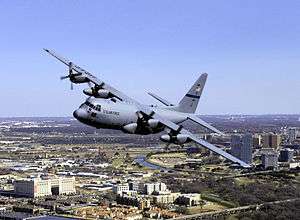

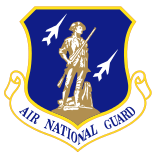
.svg.png)
.jpg)
